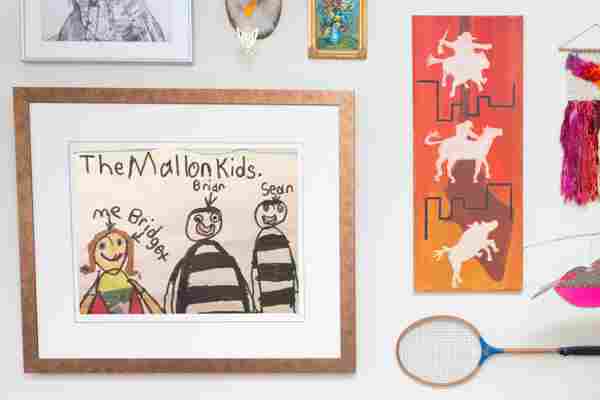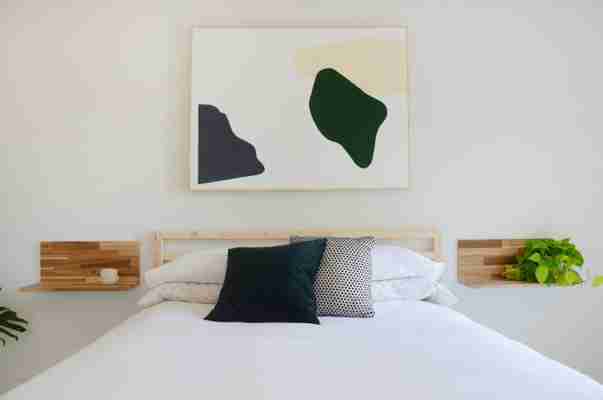
Do you ever wonder where you get your decorating sense from? Obviously, a big part of it is learned—what you see and gravitate towards in magazines, on websites like this one, Pinterest, and Instagram. And maybe your parents have had some sort of bearing on it as well. If you grew up in a super traditionally-decorated house, maybe you lean that way now too. Or perhaps that experience has made you totally crave more modern interiors. We’ve run our fair share of astrological decorating style stories, so it could be in the stars, so to speak.
But, have you ever thought about birth order and its effect on your style? Our Design Editor, Bridget Mallon, is the youngest of three—as you can maybe guess from her artistic masterpiece above—but does that have anything to do with her love of patterns ? Or does our Editor in Chief Laura Schocker’s status as a middle child play into her love of maximalism? “There is a lot of research on how birth order affects personality traits,” says Ana Jovanovic, a clinical psychologist at Parenting Pod , a resource for parents and educators about mental health and wellbeing. “There are a lot of factors within a person’s environment and upbringing that affect their personality. Still the research can provide us with some hypotheses to test through our own experiences.” Well, let’s apply some of these birth order personality traits to decorating styles and propensities, shall we?
Oldest

First, let’s talk firstborns. Fact: They tend to be anxious. “Firstborns are usually exposed to higher level of parental anxiety,” says Jovanovic. “With their firstborn, parents are experiencing being parents for the very first time. The firstborn’s actions are usually under the magnifying glass.” As a result, and as one of the biggest reviews of birth-order studies shows , many researchers have found that firstborns tend to deal with that pressure by having a higher level of anxiety. So how to deal with that? Decorating with calming influences, obviously. Think: “white or gray walls, plain flooring, the simplest of light fixtures and lots of plants,” says Taryn Bone, Principal Architect and Interior Designer at Bone Collective Studio . “The life of greenery is calming.” Go ahead and throw soothing symmetry on that list too, whether it’s matching table lamps or a pair of nightstands in the bedroom. And don’t forget curved furniture. Boxy, sharp angle shapes are slightly less appealing because they’re low-key anxiety-inducing.
Greenery also speaks to the firstborn’s tendency to nurture. “Some of my clients who are firstborns in their families feel more obligated to provide for others, to assume responsibility, or to define the rules once they perceive things out of order,” says Jovanovic. Got it. So lots of houseplants and Marie Kondo-ing for the firstborns.
Lastly, citing that same birth-order study , Jovanovic says firstborns tend to be more traditional and connected to their parents, especially compared to their younger siblings. So these folks might find themselves liking more traditional decor that reminds them of their homes growing up. Flea market finds, aged woods, and traditional turned legs are all things you might expect a firstborn to gravitate towards.
Middle
Switching gears, middle child syndrome is something that gets a lot of play in pop culture and society, but how does finding your way between older siblings, who get more responsibility, and the younger ones, who get more indulgences, play into decorating style exactly? Well, according to Jovanovic, middle children usually relate well to people and develop better communication skills. So these guys might gravitate towards a neon sign or typographic print in an interior. It’s not in the middle child’s nature to be subtle. Splashy is a better descriptor for sure.
Middle kids also tend to love anything that really communicates their personality or says “look at me,” from collectibles to one-of-a-kind art or even a cool graphic rug or throw.
Youngest
And on to the last-born. “Youngest children are usually treated as the ‘babies’ of the family, circled by the attention,” says Jovanovic. “They want to do things not only well but better than the older kids, thereby proving that they are not the ‘babies’ others may feel they are.” So if you’re a last-born, you might find yourself into more sophisticated, glam pieces and intricate silhouettes. Hollywood Regency is your spirit decorating style. Because you’re fancy like that.
Additionally, says Jovanovic, the youngest “may also feel the need to differentiate themselves from all the other kids by doing something different and unconventional, that other kids still haven’t thought of.” Hello, punches of color and pattern, says Bone. (Hmm, maybe that’s why Bridget gave herself such a colorful shirt in her drawing, while dressing her brothers as jailbirds. Classic youngest child). You’d totally consider a wallpapered dining room or accent wall. I mean, that’s something we all want to do, in theory, but the youngest kids definitely just go for it.
“Other ways to be bold are with statement light fixtures like a funky chandelier or lounge chair,” says Bone. “On the simpler side is to have bright and punchy throw pillows and blankets.” So you definitely like a little unexpectedness in your interiors. You are willing to go after a trend because it shows your inventiveness.
Only Child
Don’t worry, only children, we haven’t forgotten you—as if you’d believe that anyway. That same birth-order study cited above found that only children display lots of firstborn tendencies, both in terms of drive and focus on achievement. There tends to be a little selfishness there (or should we just say unabashed self-love?) since you aren’t used to sharing the spotlight with siblings. And only children tend to be incredibly ambitious as opposed to anxious. How does this translate decoratively? Well, only kids, you are the ones mixing patterns, textures and colors like savants. You pick a style or a palette and definitely follow through on it. You also can layer—rugs, textiles, lighting options within a room—like design pros.
So what do you think? Spot on or totally off? Mine’s not too far from the truth, so I feel like this isn’t the craziest idea. There just may be something to this logic.

Leave a Reply